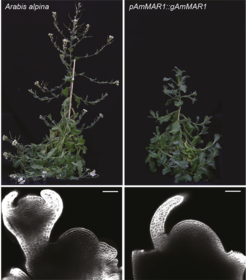Flowering of annual and perennial plants is delayed by changes in the position and number of MADS-box genes
Scientists at the Max-Planck Institute for Plant Breeding Research in Cologne hybridized closely-related annual and perennial species of the Arabis genus and identified a gene encoding a MADS-box transcription factor that delays flowering. The gene is present in the annual species but not in the perennial. A combination of phylogenetic comparisons, genome sequencing and expression analyses among Arabis species and accessions, and other crucifer species, revealed that during evolution, the MADS-box gene arose by duplication and movement to a different chromosome and has been retained in the annual species by evolution probably to compensate for the reduced activity of other related genes. The study highlights the value of using genetic crosses and genomic comparisons between closely-related plant species to understand the evolution of adaptive reproductive traits involving gene families.
Plants differ in their lifecycle: some are annual and flower once before they die, whereas others are perennial and continue to flower in successive seasons and often live for many years. The timing of reproduction critically ensures that flowers mature at an appropriate time during the seasonal cycle to produce an optimal number of seed and maximize fitness. A study published in Proceedings of the National Academy of Science USA (PNAS) by Eva Madrid and coworkers from the laboratory of George Coupland describes the use of two species of the Arabis genus of the Brassicaceae family to identify differences in the activity and function of a group of genes that determine flowering time in annual and perennial brassica species and highlights the mechanisms of their evolutionary divergence.

The researchers crossed the annual species Arabis montbretiana with a closely-related perennial species, Arabis alpina, and generated stable introgression lines that contained genetic material from both parents. When the lines were screened for plants that showed altered reproductive traits, several flowered much later than the A. alpina parent and were found to contain segments of chromosome 2 of A. montbretiana in the A. alpina background. This region contained two copies of a gene from A. montbretiana that encode a MADS-domain transcription factor related to the MADS AFFECTING FLOWERING (MAF) cluster of floral repressors of other Brassicaceae species, and these genes were named A. montbretiana (Am) MAF-RELATED (MAR) 1 and 2. The researchers confirmed that introduction of one of these genes, AmMAR1, into A. alpina delayed flowering by repressing the expression of many genes involved in the early stages of floral transition at the shoot apex.

To understand the evolutionary divergence of MAR1 and how its function contributes to the regulation of flowering time among related annual and perennial species, the researchers looked to see whether MAR1 is present in other brassica species and performed a detailed comparison of the sequences of MAR and MAF proteins among these species. No MAR genes were found in the genomes of Arabidopsis thaliana or more distantly related crucifer species, suggesting that they arose during the evolutionary diversification of the Arabis genus. Notably, MAR1 was also present in the annual species Arabis nova subsp. Iberica, but was absent in six accessions of perennial A. alpina collected across its geographical range. This suggests that the presence of MAR1 in annual Arabis species has been favoured by evolution and that MAR1 was lost in A. alpina after its separation from the lineage leading to A. montbretiana. Arabidopsis possesses several MAF genes and these are conserved among the Arabis species studied. The A. montbretiana MAR genes are most closely related to MAF1 in A. thaliana, but they are present at a different position within the genome. Therefore, the authors conclude that the transposition of an ancestral MAF1-LIKE gene to a different position in the genome generated a MAR gene in A. montbretiana, which then duplicated to create MAR1 and MAR2, and strongly delays flowering.
During evolution, the duplication of genes and their subsequent functionalization can contribute to the appearance of novel traits and help plants adapt to their environment. The relevance of the amplification of the MAF and MAR genes in different brassica species is related to their flowering behaviour, particularly in response to low temperature, which is called vernalization. All these genes, in addition to the related FLOWERING LOCUS C and its orthologues, are expressed at high levels before exposure to vernalization and repress flowering, but are downregulated during vernalization and subsequently promote flowering. However, in annual Arabis species, MAF genes are expressed at a lower level and are more rapidly downregulated than in perennial Arabis species. To compensate for these differences in expression, a stronger selection pressure has probably caused the retention of MAR1 in annual than in perennial Arabis species in response to environmental temperature.
The study highlights the value of the detailed phylogenetic analysis of gene clusters in closely-related plant species to characterize functional differences that have modulated adaptive flowering responses.

